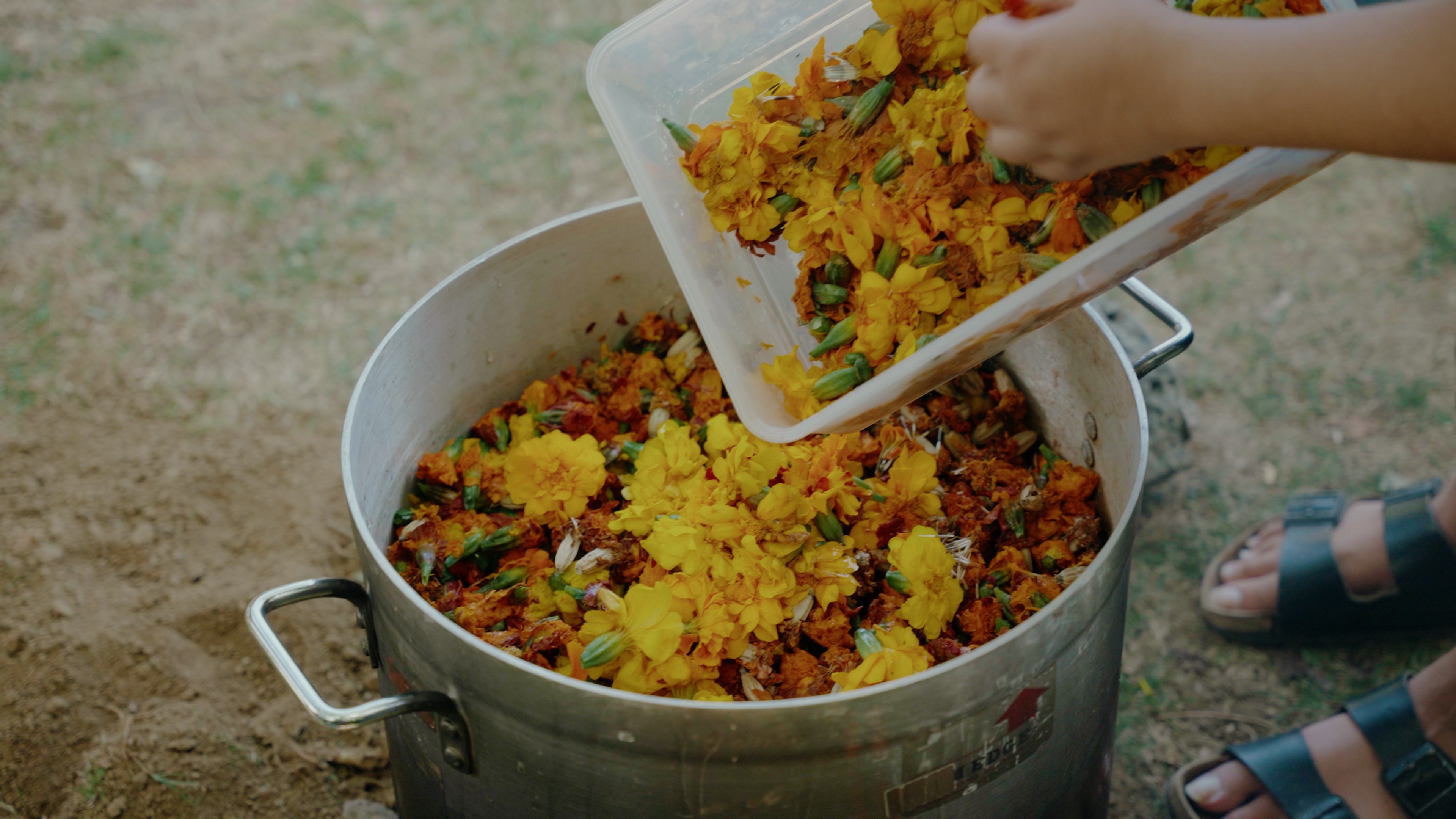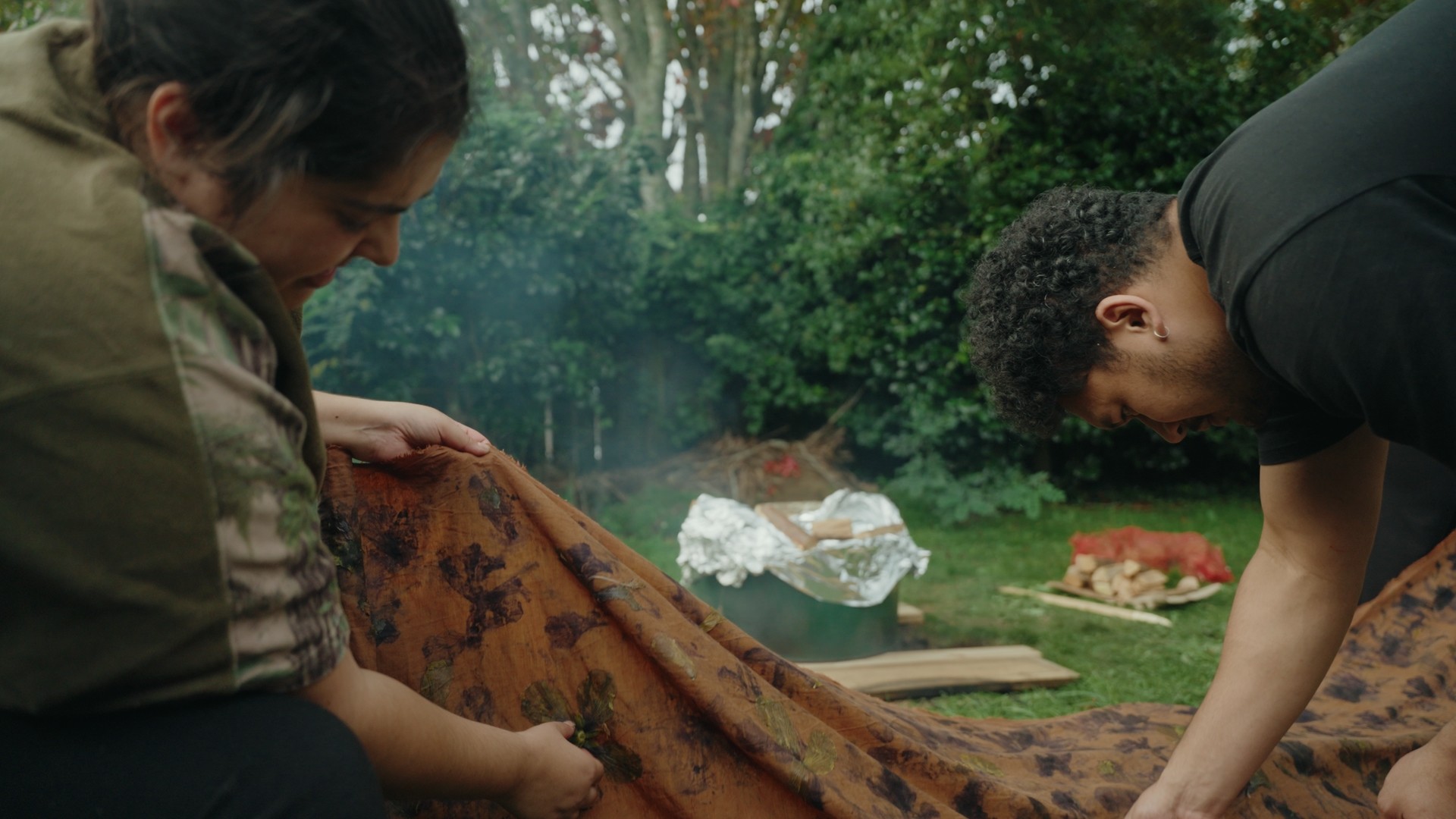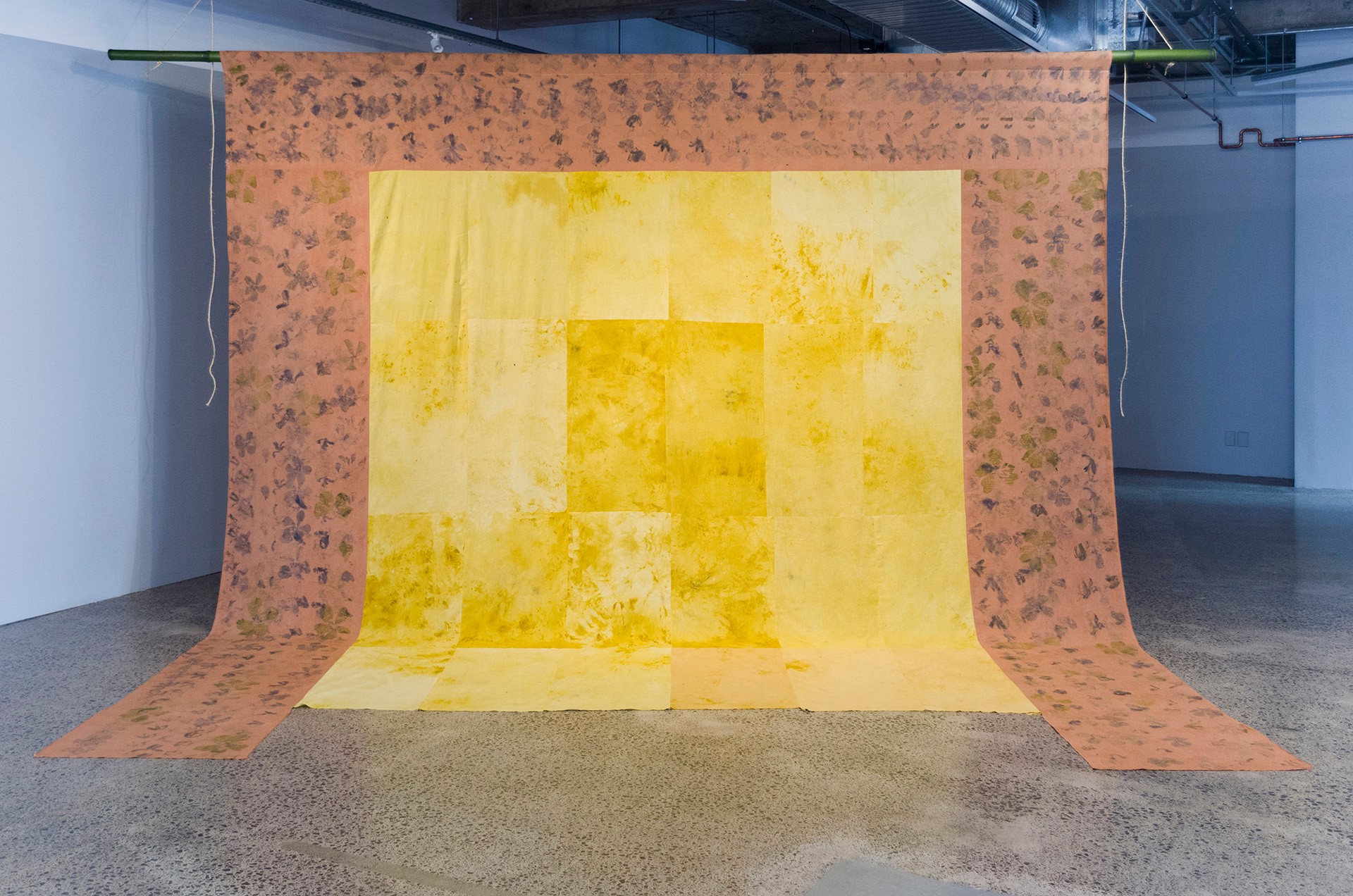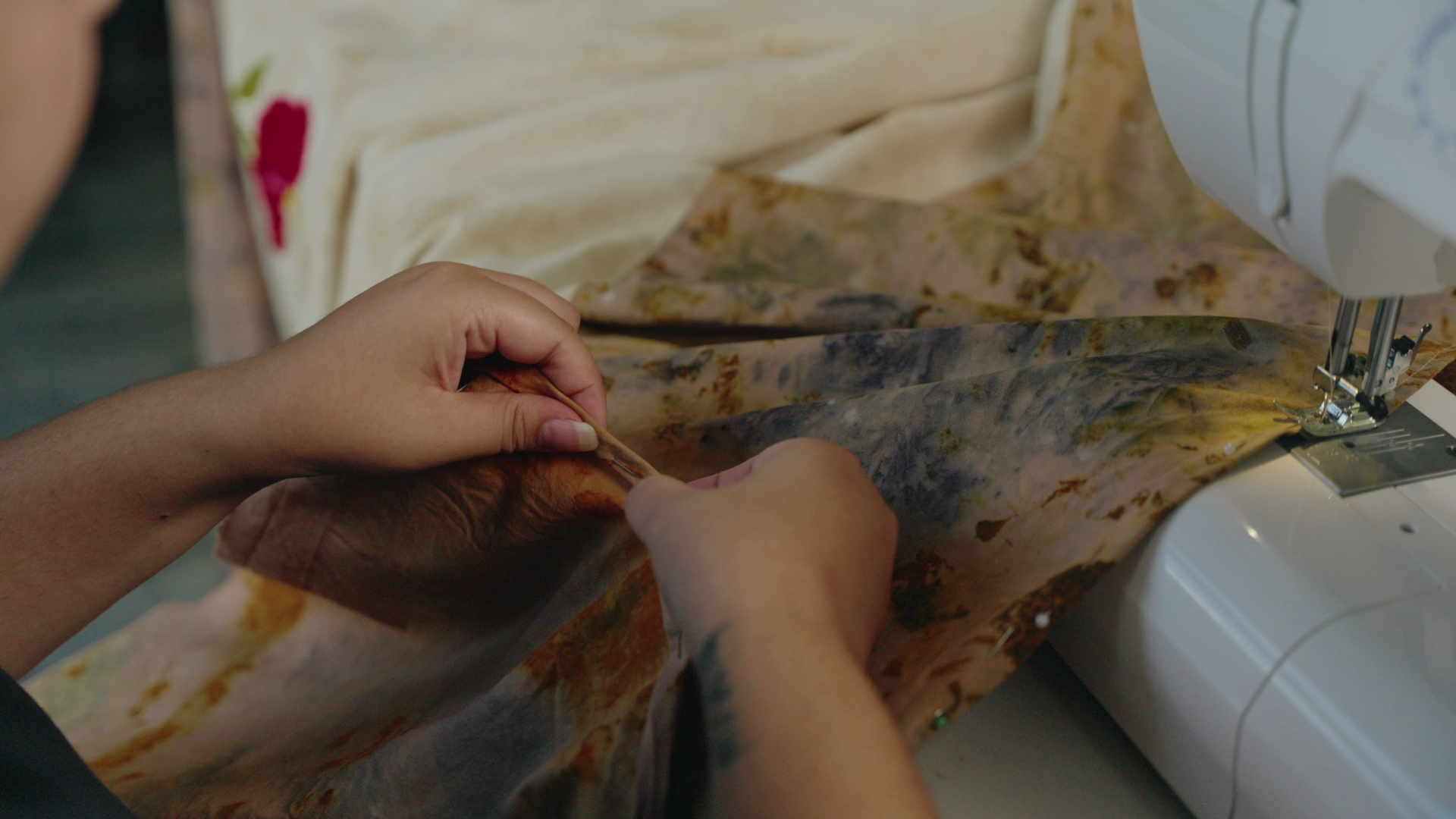INFO
| Name | Quishile Charan (she/they/machete) |
| Ethnicities | Fiji Girmitiya and Pākehā; identifies as Indo-Fijian |
| Artform | Visual arts, Craft/Object |
| Decades Active | 2010s, 2020s |
ABOUT
Quishile Charan¹ is a craft and social practitioner, researcher, writer and critical theorist who works to push against the state-approved dis- and misinformation into which Fiji Girmit histories and resistances — especially those led by Girmitiya women — have been violently subsumed across generations. Carrying with her the experiences of moving through the world as a working-class, queer and neuro-diverse Indo-Fijian anarchist, Quishile returns her ancestors to the centre of their own histories of anti-colonial struggle. Through this process, she envisions and builds decolonial futurities for her communities. Quishile builds worlds out of cloth, making large- and small-scale installations comprising quilts, embroideries, and printed and embellished textiles.
Quishile does not identify as 'Asian', noting in conversation with artist and writer Casey Carsel, who worked closely with Quishile on the writing of this entry:
Asian is a lazy identification the New Zealand settler state has assigned to my people retroactively in order to erase the state as one of the primary (ongoing) colonisers in Fiji, and to continue a history of displacement towards Indo-Fijians that ensures pliability towards state ends. Self-determined Indo-Fijian identity is instead centred around belonging as non-Indigenous Fijians to Vanua and iTaukei, and, outside of that, to other Pasifika communities. In knowing that individuals and institutions will carry out the work of the state towards Indo-Fijians, this bio nevertheless sits in this archive as resistance to the erasure and assimilation of my community and in the hopes that any young person from my community will find refuge in these words.
The notion of collective memory is a touchstone in Quishile’s practice. In the naturally dyed and embroidered textile Burning Ganna Khet (2021), she uses her visual language to process her many memories of sugarcane fields ablaze. The burning of sugarcane is one of the steps in its farming process and has been practiced by Quishile’s family for generations. In this large-scale work, she embroiders the thick fire of burning sugarcane in dense rows of embroidery that turn to grey plumes of smoke at the top.
Burning Ganna Khet represents the culmination of many material experiments, with the aim of creating a cultural visual language that encodes collective memories for those who are meant to know them. Aware that exhibiting publicly will always carry an unknown audience, Quishile utilises this coded visual language to ensure that certain stories and histories are protected.
The sight of burning sugarcane is familiar to many Indo-Fijians, with each individual bringing to it memories that align with, as well as diverge from, the collective. Burning Ganna Khet was a turning point for Quishile in asking how baat karo and khissa function in and for the Indo-Fijian community, and laid the foundations for her later approach to her work. In writing about Quishile’s work on the occasion of her 2022 dual exhibition with Zaiba Khan at West Space, Collingwood Yards, Casey Carsel notes that Quishile reproduces the sight of the burning sugarcane “to honour women’s participation in the harvest, their support of other labourers as caregivers, and their craft work, emphasising the inter-connectedness of these activities in the weave of daily life.”
At the same time, between 2020 and 2021, Quishile and California-based writer and researcher Esha Pillay transformed into the Girmit collective Bad Fiji Gyals. Together, the pair interviewed Indo-Fijian activists and researchers and published essays on Girmit histories, amongst other activities.
At the 13th Gwangju Biennale in 2021, Bad Fiji Gyals presented works created by Quishile in response to the 1920 women-led Indo-Fijian labour strikes in Suva, Fiji. As part of this presentation, Quishile appliquéd the statement “we do not have enough to satisfy our bellies”—a slogan chanted by those participating in the strike—onto a nearly 5-metre protest banner.
The protest banner has been one of the many resistance tactics deployed by Indo-Fijians, and continues to feature at protests around the world today. Legally restricted from public gathering and protest, earlier Girmitiyas resistance — including by the Women’s Gang — took on more embodied forms such as sabotaging machinery; running away; refusing to work and enacting slow labour; and beating up, pissing and shitting on plantation overseers. By incorporating the form into her practice, Biennale Curator Michelangelo Coraso writes that Quishile materialises “the physical and corporeal memory” of her family and community’s traditions of both craft and resistance.
Emerging from these dual legacies of craft and resistance, Quishile recognises galleries as inherently non-neutral spaces to which she brings her politicised body, noting in her PhD exegesis:
No space is neutral, just as safety is relative. The arts and academic institutions, then, are a tricky site of domination, posing as both private and public space, conflating their “educational” (university) and “cultural” statuses (the arts) with their true business-capitalist-colonial desires, hiding behind a saviour mentality, itself a missionary mindset.
So when, in 2023, Quishile received a commission from Artspace Aotearoa to present a new work for the group exhibition Scores for Transformation, she recognised in it a challenge to take up space while keeping her cultural knowledge safe and her work imbued with the love and care so central to her practice.
This challenge has been a question deeply intrinsic to Quishile’s practice since the beginning. In a 2020 interview with Dilohana Lekamge for Enjoy Public Art Gallery, Quishile points out that there is no word for art in Fijian-Hindi:
Art as a concept intrigues me because I come from a creative background, but I don’t think the Western idea of art completely encapsulates what I’m doing. The best way to describe the way I work in the art industry is to acknowledge that it’s a platform that I can use and that can support me.
In response to this challenge, Quishile created a large-scale textile out of panels of dyed cotton-linen that would later be deconstructed to make several pillowcases and quilt blocks for her loved ones. Named Araam, the work was suspended from the ceiling, hanging from a bamboo pole down to the floor.
Dyed with cutch, hibiscus and genda, Araam marked a key point of maturation in Quishile’s natural dye practice. The dye work was done old-school-style in a lovo pit, and involved her whole family in its creation. Describing the work in her PhD exegesis, Quishile points out the intentionalities of scale that Araam employs:
Returning to large-scale textile installation provided an important space for my dye practice to continue to deepen and grow, but it also was the action of my oppositional resistance in ensuring that I gave voice in a space that would usually render me voiceless and disembodied. Araam demands the attention of its audience through its vibrant colours that recalled the colour palette of the islands, of Fiji. The work itself had a type of confidence grounded in its own knowing of its history, stories, significance, and value.
Araam marked a turn in Quishile’s practice towards looking beyond the gallery space even during her exhibitions — creating works that are initially shown in one space but then deconstructed into new lives afterwards. In the essay “Mera Tabba”, Jasmin Singh notes how in this work “Quishile challenges the boundaries that get pushed upon craft in a contemporary arts context”. Even in the gallery space, Quishile does not abandon the domestic alignment for which craft is so often maligned in a contemporary context, instead embracing the homes of her community as the true dwelling place of the work.
Community is constantly flowing through Quishile’s work. Across all facets of her practice, she asks how she can welcome family and communities of multiple generations into pulling apart the arts contexts they are usually excluded from. She welcomes her loved ones into the process of creating the work at every stage, including recording the process.
An important step in Quishile continuing to build out her visual languages of the past and present while working towards radical futures was her solo exhibition, It takes the love of the living and the dead (2024). Presented as part of her PhD at Te Wai Ngutu Kākā gallery at Auckland University of Technology, Quishile sought to create a space in which her community could see themselves and feel comfortable.
The exhibited works — quilts, pillowcases, embroideries, videos — held her community in many ways. They were held in the flowers that they had placed upon the fabric before it was dyed. They were held in the stitches they gave to the work. They were held in the familiar mats and benches on which they were invited to sit. They were held in the scenes of home depicted in thread. They were held in the knowledge that there was a pillowcase hanging on the laundry line that was just for them, not for sale to anyone else, as Quishile’s work has never been for sale to institutions or collectors, as noted in her PhD exegesis and in conversation: “the sale of my work doesn’t ethically align with my practice; instead I choose for my work to go directly to my community — the homes of my loved ones are its real home”.
Quishile’s community was held not just in the works but in the colour in the space, the sounds, the smells. Before the exhibition opened, Quishile’s loved ones blessed it, including through puja, which left the scent of incense wafting through the space. Mirchi FM — radio being an Indo-Fijian household staple — played overhead in one of the gallery spaces, while in the other were the sounds of the videos that recorded the process of bringing the works to life — sounds of conversation, laughter, music. The walls were painted the buttercup yellow that for Quishile holds the warmth of an Indo-Fijian home, and the quilts and pillowcases were hung from the laundry lines that make up part of the rhythm and flow of daily Indo-Fijian home life.
Reflecting on this exhibition as a culmination of her thinking around her practice thus far, Quishile points to the worlds the installation brings together:
My textile practice creates landscapes that hold the continuation of Indo-Fijian cultural practices and how they inform one another, from gardening, cooking, craft, storytelling, language, and music to caring for and being in relationships with one another. … My graduate exhibition has functioned, in its lead-up, in two modes: one of resistance and the other of continuing my responsibilities of craft to my elders, the responsibility to learn everything they know. The latter is deeply and intrinsically tied to Indo-Fijian self-determined futurities. In considering how these two modes of making can exist at once, making gifts of textile memories for loved ones became an intentional grounding. Craft can only exist within the communities that nurture and care for it; it functions specifically through living and building a life with the community from which it comes. I honour my family and my chosen family, weaving them into the infinite fibres of the textile worlds and landscapes I create.
In this exhibition and beyond, as Quishile builds her practice, she seeks to build a life around the everyday acts that together make up Indo-Fijian cultural ways of being. She builds this life not only for herself but for her loved ones and so that the next generations of rangitahi might find a sense of belonging in communities that will embrace them.
—
¹ In her PhD exegesis, Quishile expands upon the problematic positioning of Indo-Fijian identity by colonial powers:
Frequently the question of identity and belonging has been positioned and leveraged against Indo-Fijians as a means of further silencing/invisbilising us, and as a means of assimilation. But why? The very mechanism of colonial control that exists for Indo-Fijians is, in my opinion, two forms of neo-colonial power: a history of indentured labour, which has created institutional racism for Indo-Fijians, and the denial of our rights to self-determine our identities and futures.
In her PhD Quishile also reflects on the weight of the archives upon her people’s histories:
…moving us from voiceless labourer to voiceless academic subject, wherein we are picked apart and reconstructed into identity binaries without our consent. How, then, do we determine ourselves, our identities, and communities? Even in the very histories that would not exist without us, we are denied our autonomy. The Girmitiyas women who led our anti-colonial and decolonial struggles are replaced by elite nationalist Indian men and their counterparts (white missionaries and middle-class, upper-caste women). We were never afforded the leading role in our own histories, instead outsourced into the passive and subservient racial identity constructed of us, but not for us or by us.
For further context, please see the work of the Bad Fiji Gyals collective.
LINKS
Mera Tabbar by Jasmin Singh, written in response to Aaram
For more context about Fiji Girmit, please see: Esha Pillay & Quishile Charan, "Coolie Cut Cane: The Sugar Empire of the South Pacific", Bad Fiji Gyals Collective (2021), Esha Pillay & Quishile Charan, “Undoing History’s Spell on Bad Women: Counter-colonial narratives of the female Girmit role in the 1920 labour strike”, Bad Fiji Gyals Collective (2019), badfijigyals.com; and Quishile Charan, “She Cut Me from Ganna”, master’s exegesis (2019).
Key works / presentations
2024 — It takes the love of the living and the dead, Te Wai Ngutu Kākā Gallery, Tāmaki Makaurau
2023 — Scores of Transformation, Artspace Aotearoa, Tāmaki Makaurau (group exhibition)
2023 — Araam, Te Tio Kikorangi Blue Oyster Project Art Space, Ōtepoti
2022 — Angna Mein, West Space, Melbourne (group exhibition)
2021 — 13th Gwangju Biennale, South Korea
2018 — Your Woman is a Very Bad Woman, First Draft, Sydney (group exhibition)
2017 — Namesake, Enjoy Contemporary Artspace, Pōneke (group exhibition)
Key awards
2024 — Dame Dorothy Winstone Doctoral Completion Award, Kate Edger Foundation
2018 — Iris Fisher Scholarship, Te Tuhi





